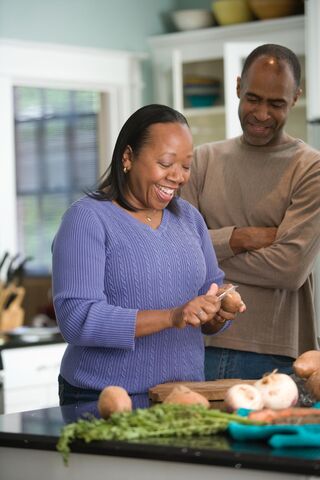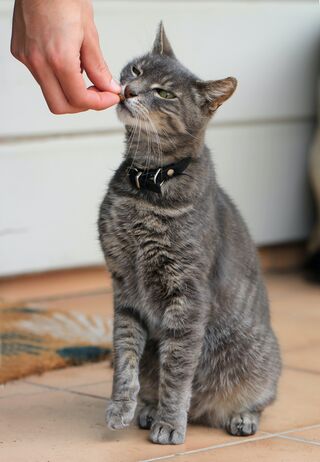Animal Behavior
Fido and Food Therapy: Nurturing Our Pets to Heal Ourselves
Why feeding other animals can be so therapeutic during the global pandemic.
Posted May 26, 2020
The experience of living through a pandemic is at once strange, uncertain, scary and for many, downright heartbreaking. The rapid, global spread of the novel coronavirus and ensuing social distancing, shelter-in-place or lockdown orders, quarantine, and life-threatening cases of COVID-19 among friends and family has many people drawing from deep wells of strength and a variety of coping strategies. Food therapy, in its various forms, is quite literally on the table right now.
Chicken Soup for the Soul

While stress-eating is an ever-present vice, food as therapy is one emerging trend we’re seeing in the news, on social media and in our homes that extends beyond the sentimental connotations of “chicken soup for the soul.” Attending to hunger is a basic need, but there’s a deeper well of emotional nourishment involved in the act of preparing, serving, and enjoying a meal together. For those who are able to stockpile goods and have access to groceries, as well as those who can’t provide for themselves, meals (both home-cooked and delivered) have taken on a whole new level of importance. Many of us are learning for the first time what it means to ration food. Most, if not all of us, are giving deeper thought to the act of feeding our loved ones. Food consumption is top of mind right now, including what we feed our pets and local wildlife.
Kitchen Therapy
Many aspects of meal preparation and cooking have therapeutic value. In her Psychology Today article “Kitchen Therapy: Cooking Up Mental Well-Being,” Linda Wasmer Andrews discusses how culinary therapy can be applied as a treatment for a range of mental and behavioral health conditions, from depression and anxiety to ADHD and addiction. People can practice mindfulness in the simple act of chopping vegetables, for example. Andrews mentions other aspects of culinary therapy, including creativity (exploring new flavors), joy (it’s a more fun task than laundry), appreciation (reflecting on how the food reaches you or even the beauty of a piece of fruit) and connection (cooking together, eating together). All of these elements of food therapy can also be applied to the act of preparing a meal for an animal, as well. To feed or offer food to someone, be they human or animal, builds trust, empathy, compassion, comfort, eases stress, and promotes positive affect for both the provider and the receiver.
Feeding Our Pets

Diane Ganev, an occupational therapist from Los Angeles, CA, began cooking for her dog Bella over a decade ago. Bella is a 13-year-old Dachshund/Pomeranian mix who enjoys freshly made meals consisting of ground turkey or chicken, carrots, pumpkin puree and/or pureed blueberries. These ingredients form a meatloaf-style meal for Bella. Ganev says a book called Food Pets Die For by Ann Martin and many pet food recalls are what initially prompted her to begin making homemade dog food. “Bella is like a daughter and my best buddy,” says Ganev. “I think [she] may have some understanding that her meals are more unusual than some of her peers … when I do switch up her meatloaf, there are some versions she gets very excited about and tends to devour faster than others.” Ganev says making homemade meals for Bella helps her feel joyful and more connected to her dog. After making meals from scratch for so many years, Ganev says it’s become part of her own routine and has even helped her to include more vegetables in her own (human) diet.
Food Is for the Birds
Domestic animals are not the only ones who benefit from specially made meals by humans. People have long been feeding birds bread crumbs, as well as store-bought blends of bird feed for pets and local feathered friends. Janet Connolly, the co-owner of The Audubon Shop in Madison, CT, has been interested in wild birds since she was a child. Like Ganev, Connolly — whose family includes a number of professional cooks — says feeding them is part of her routine now, but she also finds the activity “fun and relaxing.” She and her husband are dedicated to improving their yard for native wildlife, in an attempt to bring back all “the creatures that would normally inhabit the area.” Part of these efforts include making treats for hummingbirds and bluebirds. The Connollys have set up feeders at home and at the shop, and they keep them filled year 'round. (See Janet Connolly’s hummingbird nectar recipe here.)
“The nectar is fun to make because that means warm weather and [the arrival of] amazing Ruby-throated Hummingbirds (the only Eastern US Hummingbird). They are amazing to watch, and to realize that something less than an ounce migrates so far — wow,” says Connolly. “We also make a Bluebird dough that nourishes Eastern Bluebirds in the months leading up to nesting time … Some times of year are busier at the feeders than others. We enjoy marking the seasons by watching the birds.” Connolly notes that birds are “survivors” and part of a healthy ecosystem. And for those who enjoy growing their own food (gardening is therapeutic in of itself), hearing birds singing outside makes the activity that much more enjoyable. In the age of Coronavirus, those who have the luxury of access to backyards, gardens, or local forests can and should try to spend time outside, communing with nature to maintain their mental health.
Elephant Food

On the opposite side of the world (and opposite size spectrum), we recently enjoyed the unique experience of feeding elephants in Thailand. At ChangChill, an ethical sanctuary in the mountainous jungle region of Chiang Mai, tourists do not partake in the typical but questionable practices of riding elephants, bathing them, playing, and taking selfies with or touching them in any fashion. Instead, sanctuary guests follow the rescued and/or retiree elephants along the course of their day, trekking across the vast property with their mahouts (traditional elephant-keepers, usually inherited through family). After the elephants’ morning outing, we filled “puzzle” feeding stations full of sugarcane and banana leaves for the pachyderms to reach into with their trunks and grab a snack. Later, an “elephant shaman” taught the group how to make “medicine balls” or vitamins for them. This ChangChill experience allows people to take part in mixing up local herbs, salt, Japanese pepper, rice, banana leaf, cardamom (their favorite smell), tamarind (a natural laxative) and more ingredients to treat various elephant ailments, but there is no direct interaction between elephants and visitors.
Some question why tourists would want to learn how to feed elephants when they could just take a selfie with one. ChangChill is trying to change this mindset. Here, elephants choose to come and go without being forced to entertain people. Thus, both elephants and their mahouts are more relaxed. According to Drinya Totrakool, Elephant Venue Project Manager at World Animal Protection, limited contact with the animals encourages natural explorative behavior that stimulates the elephants: “Visitors can truly see elephants for what they are and get to observe their natural behaviors that they would do in a natural environment...The [elephants] learn that the visitors prepare food for them, hence they wait around while the food is being made … We assume that associating visitors with passive observation and food preparation is likely more pleasant for the elephants [versus] having to comply with commands, be closely handled by a stranger or ridden every day.”
Although there’s a long traditional history of the elephant-mahout bond, Totrakool reminds us that the human is the boss in this often romanticized relationship. While there can certainly be a harmonious mutual bond and emotional connection between the species in some special cases, the fact is that the human controls the elephant’s every move and provides the food. Biologically, elephants remain wild animals, and as such, there are inherent safety risks to people — and welfare risks to the elephants — when they are kept in captivity. To that end, elephant-friendly sanctuaries (that don’t focus on entertainment) such as ChangChill promote “social distance” between visitors and the animals as a method of maintaining a positive bond between the species. In our experience, just observing these majestic beings in their habitat, roaming freely at a safe distance and having the unique honor of preparing food for them and watching them enjoy it filled our hearts and souls with joy and wonder.
Try This at Home

Most of us are not in a position to feed elephants right now, and some people may even find it a financial challenge to properly provide for their pets. However, for those pet parents who may be stuck alone in their homes with only a cat or dog (and the means to share their “human food”), preparing fresh meals may be a surprisingly fun and enriching experience for you both. And for anyone without an animal in their home, stepping outside or opening a window to set up a bird feeder could be a whole new source of entertainment, education and a potentially meditative activity. Sharing food, even with an animal, can be a communal experience. During these trying times of stress, grief, loneliness, and isolation, we highly recommend reaching out to feed a furry and/or feathered friend (reptiles, amphibians, and fish count too!) to ease your anxiety and lift our spirits.
Guest blogger Saryn Chorney was the primary author for this article, with edits by Dr. Katherine Compitus.
To find a therapist, please visit the Psychology Today Therapy Directory.
References
Andrews, L. (2015, May 19). Minding the Body Kitchen Therapy: Cooking Up Mental Well-Being Cooking a healthy meal nourishes your mind and feeds your soul.
Boehme, K. (2020) What Is Food Therapy? Drake Center for Veterinary Care
Burke, A. (2016, July 10). Millennials’ pets eat better than you




